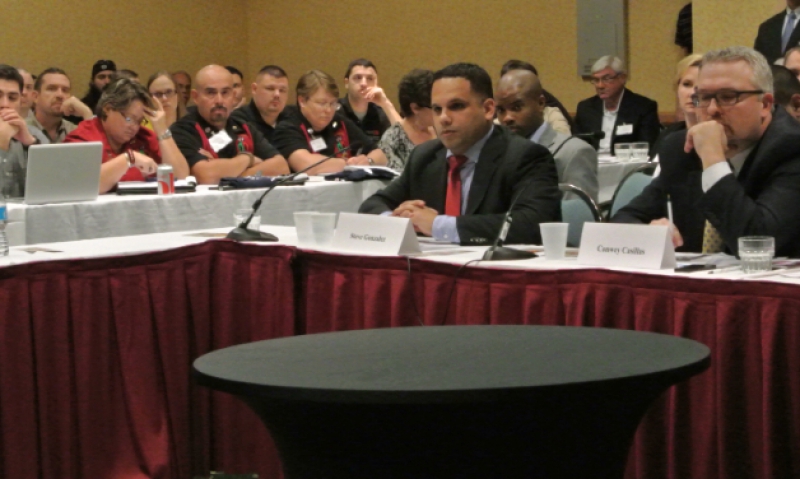
Student Veterans of America brokers data deal
More than 600 student veterans, education officials and military supporters met in Orlando the first weekend of January for the fifth annual Student Veterans of America (SVA) national conference, held at the Florida Hotel & Conference Center. Attendees shared experiences and best practices for improving their SVA chapters on their respective college campuses, but remained focused on the big picture: improving the academic climate for student veterans everywhere.
Serving as the conference’s keynote speaker, VA Secretary Eric Shinseki announced what could be the most significant Post/9-11 GI Bill-related development since the landmark education legislation was implemented in August of 2009. Shinseki used his address to formally announce VA’s collaboration with the National Student Clearinghouse (NSC) to share data on servicemembers using the GI Bill at educational institutions.
NSC collects and maintains data for around 96 percent of college students nationwide, tracking rates for graduation, matriculation, and enrollment and dropout. The collaboration will allow each organization’s respective data to be compared – hopefully yielding the first concrete statistics for rates at which GI Bill users graduate and dropout.
Officials say that a reliable graduation rate for student veterans could provide crucial support for extending military education benefits, and even give ammo to combat any proposed cuts to the GI Bill that could arise from a Capitol Hill that would prefer to cut rather than spend.
“Having that information is critical,” said Michael Dakduk, executive director for SVA. “To find out whether student veterans are succeeding is what we need to find out the value of the GI Bill and especially to combat stories and speculation that veterans are not succeeding in college.”
SVA is the third partner in the relationship between NSC and VA. It was officials from SVA that brought NSC and VA together and explained the importance of transparency between the two organizations and the need to share information.
Dakduk says reliable, concrete data about servicemember graduation is essential to finding a true return on investment for the Post/9-11 GI Bill, which VA estimates has paid out around $24.4 billion in three years. An actual number will completely dispel the erroneous 88 percent dropout number that was forwarded by several media reports last year.
“If the information is good, we have a way to defend the GI Bill,” said Matt Feger, director of development for SVA. “If it’s bad we can fix it, and then still defend the GI Bill.”
Feger says preliminary reports and comparisons are already showing that servicemembers are graduating at or above the same rates as non-military students. He’s also excited about finding schools that are graduating their veterans at particularly high rates and using them as a model.
“If there are schools that are performing well, we can replicate them,” Feger said.
The general concept of locating top-performing schools and replicating their practices is something that was stressed during SVA’s entire three-day conference. SVA chapters, like the one at Florida State, that are performing well and graduating student veterans at a high rate were invited to present at the conference to show attendees how they’ve managed to be successful.
Chapters are the “posts” of SVA’s organization that house its members. There are around 21,000 SVA members on college campuses in all 50 states and two countries abroad.
“Folks at Florida State can learn from folks at the University of Arizona,” Dakduk said. “That interaction wouldn’t have otherwise happened. This interaction in person is absolutely paramount to keep folks engaged in our organization.”
The conference marked a celebration for SVA as it enters its fifth year of existence. Founded in 2008, SVA was formed out of a conglomeration of student veterans organizations on college campuses around the country. Their rallying point was the new GI Bill, which was then being signed into law.
SVA started with chapters on only 20 college campuses. The organization has grown exponentially to have more than 700 chapters - 150 of which chartered in the last year.
Dakduk says each chapter generally has a three-pronged mission: to provide a peer support network for the school’s veterans, to drive veteran friendly policy at the school, and to engage the campus and surrounding community with service-orientated initiatives.
“We’re all across the spectrum,” Dakduk says. “We have student veterans everywhere organizing and supporting one another and changing the landscape of higher education to be more supportive of military veterans and their families.”
As finding a true number for servicemember graduation rates becomes more of a reality, Dakduk says SVA’s focus turns to eliminating the education benefits backlog – which had over 58,000 unprocessed claims in October – and instituting in-state tuition costs for veterans at every state school, regardless of the veteran’s legal state of residency.
Steve Gonzalez, assistant director for the Legion’s Economic Division, participated in a roundtable discussion at the SVA conference that focused on the future of education benefits for student veterans. Gonzalez said the plan to get in-state tuition for all student veterans is best suited for lobbying efforts at the state level, not federal level.
“Getting in-state level tuition for all veterans regardless of their state of residency is something that remains a high priority for the Legion,” Gonzalez said. “At this point, the best route to get this seems to be by lobbying individual states. The Legion looks forward to partnering with SVA in this initiative.”
The Legion also made a $10,000 donation to SVA, as it did at last year’s conference.
Dakduk says the education backlog and in-state tuition issues are important, but the primary focus is on finding true graduation numbers for servicemembers and advocating further for education benefits.
“If we don’t (get servicemember graduation numbers), then what kind of ammo do we have to guard from potential cuts to the GI Bill?,” he said. “We have to worry about people eventually asking what the return on investment of the GI Bill. That’s why we are spearheading this effort.”
